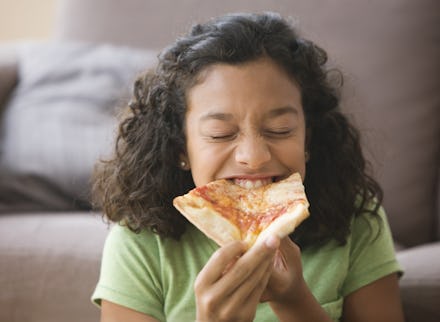Science Says Blotting Your Pizza Will Make It Healthier, But Not Nearly as Tasty

Pizza.
According to legend, it's been around for 2,000 years. In the United States, the story goes that Gennaro Lombardi became the first person to apply for a license to sell pizza in the country in 1905. Frankly, it's a national institution. And while pizza may not be the healthiest food, some say there's one simple trick you can do to peel off the calories:
Blotting.
For as long as there has been pizza in America, there has also been blotting. The persnickety and occasionally obsessive behavior of cleaning off excess pizza grease, usually with a napkin, can be found in parlors from coast to coast.
In addition to a less drippy dining experience, the primary reason for blotting is a belief that absorbing all that extra grease can make pizza healthier. If its on the napkin, it's not in your stomach or clogging your arteries, the theory goes. But is it true, or is the effect completely negligible?
For health-conscious foodies navigating the greasy $39 billion pizza industry, science does provide an answer. And the news is good.
The science: "If you're removing grease or oil from any product or any dish, it's going to reduce the calories," Top Balance Nutrition dietitian Ryan Turner told Mic. "If there is standing oil on top of a pizza, it could definitely help."
But how much would it help? Determining the exact health benefits of pizza blotting — like the grease itself — is an opaque process. To date, no single scientific analysis has ever settled the question.
A study by the Georgia-Pacific Health Smart Institute reportedly found that blotting could remove "up to 14% of total fat" and 17% of both cholesterol and saturated fat on a 15-inch pizza. A representative at George-Pacific, however, told Mic she had never heard of the study and could not confirm it was real.
A more concrete finding came from the Food Network's short-lived series Food Detectives. The show, which purported to "find the truth behind all of your burning food conundrums," investigated the value of pizza blotting and came to a definitive answer: about 3.5 grams of oil or 35 calories per slice.
Scott Wiener, owner and founder of Scott's Pizza Tours, said anywhere in the range of 35 to 50 calories a slice was a safe guess, adding it was no small feat given an average slice is around 270 calories. "There are more blotters out there than you know," Wiener told Mic. "I bet it's somewhere around 10% to 15%," he estimated of his own customers.
The case against blotting: There are tradeoffs with any health-conscious food activity, and pizza blotting is no exception. Wiener, who is an authority on pizza boxes, with a world record collection and published book to his name, never blots his pizza.
"When you're blotting you're going to be able to take off more oil, but you will run the risk of removing spices and sauce," he warned. "When sauce is on top of cheese you're really doing more harm than good. It's an invasive maneuver." Wiener told Mic he preferred the drip method, which, demonstrated on his YouTube channel, looks something like this.
The grease removal also takes a bite out of taste. "By blotting off the fat, you're decreasing your calorie count," Wiener said, but also warned that "oil is fat; fat is flavor."
For Wiener, the necessity for blotting decreases with pizza quality. In his experience pizzas using high quality cheese in more limited quantities throw off less grease.
"There's a difference between fresh mozzarella and low-moisture mozzarella," he said. "The type of pizza that gives you that grease is low-moisture mozzarella." Because of its longer shelf life, low-moisture mozzarella cheese is the preferred choice for most American pizzerias.
The call for increased quality as opposed to blotting was echoed by fellow pizza guru Mark Bello. Bello, who along with his wife Jenny founded New York's Pizza a Casa Pizza School, to train would-be pizza chefs took a dim view of the practice.
"I don't eat pizzas that require blotting," he told Mic. "Where I usually expect to see blotting is in a cheap slice place." For the 12-inch margarita pizzas in Bello's class, he says he only uses three ounces of fresh mozzarella. "Fat is part of the flavor, he said. "Enjoy that, and use less."
And so, with the battle lines drawn, there's only one question left. Blot or not? The answer is up to you.